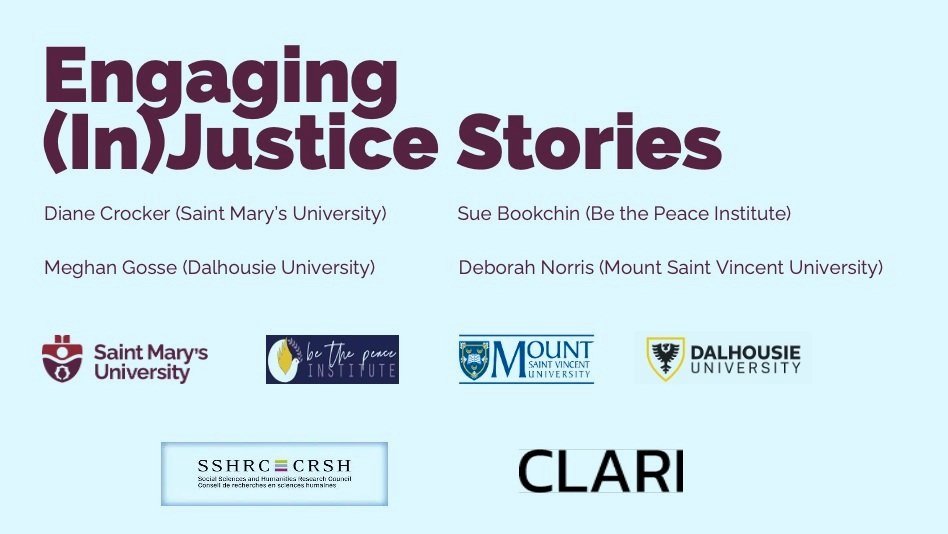Voices of (In)Justice
May 2018 - December 2021
In partnership with Dr. Diane Crocker, Professor, Criminology at St. Mary’s University and Dr. Deborah Norris, Professor, Family Studies at Mount St. Vincent University
Funded by: the Social Sciences and Humanities Research Council (SSHRC) and Change Lab Action Research Institute (CLARI), St. Mary’s University
This project will produce research that explores what “justice” means to those who have experienced gender-based violence, asking the questions:
What does justice look like for those who experience gender-based?
What principles and values must underlie both processes and outcomes for survivors to experience them as “just”?
What system changes align with these values so that survivors feel better served by the systems?
While researchers have documented victims’ negative experiences seeking justice and the gap between what justice systems provide and what survivors want, there has been less attention paid to what justice actually looks like to survivors. The answers unearthed in exploring this gap will inform Be the Peace Institute’s efforts to generate deep systemic change to enable survivors of gender based violence to find the “justice” they seek. It will focus on victims’ justice values, and what they want to achieve, rather than their complaints about bad experiences.
Research Method - Participatory Narrative Inquiry (PNI)
Narrative research methods are designed to capture knowledge about complex contexts, shifting attention away from opinions to actual stories. By asking for narratives rather than opinions, the method allows respondents “to exploit the richness of real life experience as opposed to converting it to a mini theory of their own mind or behaviour” (Stienstra & van der Noort 2008:2). We expect narratives will open up new pathways to justice obscured by more traditional research methods.
The research will:
Gather stories from gender-based violence survivors about their experiences seeking justice
Invite them to help us understand what their stories tell us about their “justice values”
Bring stakeholders together to make sense of the findings in strategizing new pathways to justice that may emerge from the stories
Use the research findings to advocate for change and inform further projects
We will explore “what happened?” when a victim sought justice, rather than asking for opinions about what went wrong. We will emphasize the importance of descriptive data.
In the Literature
Despite several decades of feminist-led efforts to promote reforms, little has changed for victims of gender-based violence who turn to the criminal justice system for help (Curtis-Fawley and Daly 2005; Daly and Curtis-Fawley 2006; Herman 2005). Problems for victims have been well documented: they do not feel that the criminal justice system takes them seriously or validates their experiences (Koss 2000; Buzawa and Buzawa 2003); and they feel humiliated, embarrassed and disempowered (Curtis- Fawley and Daly 2005; Comack and Peters 2005). Research suggests that victims want a say in justice system processes and outcomes (McGlyn et al 2012; Wemmers and Cousineau; Stern 2010).
Over the years, policy makers have worked to improve the system’s response. We have seen the spread of mandatory arrest and “no drop” prosecution policies, trauma-informed practices, survivor/victim-centred services and innovations such as specialized courts. And yet, researchers continue to document victims’ negative experiences of justice system interventions and how victims’ wishes and needs do not align with criminal justice system processes.
Complexity
Complexity theory may provide at least a partial explanation for why efforts to change the system have had limited effects. Complexity is more than a metaphor for understanding social systems. It has implications for how we design research and how we alter systemic patterns that keep replicating unintended results.
Simple problems are characterized by predictability. They present easily identifiable linear, cause- and-effect relationships, and can be addressed with facts and “best practices.”
Complicated problems require expertise to uncover the less obvious cause-effect relationships and underlying patterns. The solutions are still driven by facts.
Complex problems present as “fluid and unpredictable” (Snowden and Boone 2007:7). Because they are non-linear they require innovative responses and creative methods to uncover patterns.
Without a doubt, achieving justice for gender-based violence victims represents a complex problem. Yet our responses have relied on facts, best practices, expertise and the search for cause-effect relationships between interventions and their outcomes.
Through Participatory Narrative Inquiry (Kurz 2014: 85) in which groups of people gather and work with raw stories of personal experience, we can make sense of the complex situations they represent by reaching into the level of values and beliefs from their lived experiences.
August 2022 - Project Update
The project team completed 36 in-person and phone interviews with survivors and undergone an analysis of themes as well as pulling out specific instances about justice-seeking experiences.
We had hoped to run several participatory workshops across the province and had just started this process when the COVID-19 pandemic prevented in-person gatherings. We did run one workshop prior to local heath restrictions being put in place. After that time, the remaining two workshops were held virtually on Zoom. One workshop was with service providers/stakeholders, the other with those who have experienced gender-based violence.
We invited participants to tease out the topics and the themes of each anecdote providing us with a sense of how victims and/or stakeholders understand or interpret the anecdotes, as well as how well the anecdotes reflected two important justice concepts: fairness and respect.
Here is a report on the findings, click on image below to read more.



